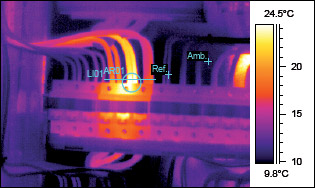 Thermography, or thermal imaging, is a type of infrared imaging. Thermographic cameras detect radiation in the infrared range of the electromagnetic spectrum (roughly 900–14,000 nanometer or 0.9–14µm) and produce images of that radiation. Since infrared radiation is emitted by all objects based on their temperature, according to the black body radiation law, thermography makes it possible to “see” one’s environment with or without visible illumination. The amount of radiation emitted by an object increases with temperature, therefore thermography allows one to see variations in temperature, hence the name. With a thermographic camera warm objects stand out well against cooler backgrounds. Humans and other warm-blooded animals become easily visible against the environment day or night, hence historically its extensive use can be ascribed to military and security services.
Thermography, or thermal imaging, is a type of infrared imaging. Thermographic cameras detect radiation in the infrared range of the electromagnetic spectrum (roughly 900–14,000 nanometer or 0.9–14µm) and produce images of that radiation. Since infrared radiation is emitted by all objects based on their temperature, according to the black body radiation law, thermography makes it possible to “see” one’s environment with or without visible illumination. The amount of radiation emitted by an object increases with temperature, therefore thermography allows one to see variations in temperature, hence the name. With a thermographic camera warm objects stand out well against cooler backgrounds. Humans and other warm-blooded animals become easily visible against the environment day or night, hence historically its extensive use can be ascribed to military and security services.
Thermal imaging photography finds many other uses. For example, firefighters use it to see through smoke, find persons, and localize hotspots of fires. With thermal imaging, power lines maintenance technicians locate overheating joints and parts, a telltale sign of their failure, to eliminate potential hazards. Where thermal insulation becomes faulty, building construction technicians can see heat leaks to improve the efficiencies of cooling or heating air-conditioning. Some physiological activities, particularly responses, in human beings and other warm-blooded animals can also be monitored with thermographic imaging.



